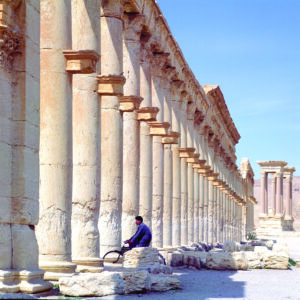By Becky Mayad
Showcasing powerfully relevant photography of Palmyra from 1989, the Edith O’Donnell Institute of Art History of The University of Texas at Dallas presents Carolyn Brown and Palmyra: An Ancient City Through the Lens. The exhibition runs through Jan. 2 at the Crow Museum of Art of The University of Texas at Dallas, located in the Dallas Arts District at 2010 Flora St.

A Dallas-based photographer, Brown is renowned for her brilliantly composed images of architecture, portraying both the beauty and distinct character of the built environment, while also emphasizing human presence and cultural heritage. This exhibition will feature 12 of her large-scale photographs documenting Palmyra (located in present-day Syria) from her travels 32 years ago. Through these works, the exhibition aims to investigate notions of cultural heritage at this site specifically but also in a larger global context.
Carolyn Brown and Palmyra: An Ancient City Through the Lens is curated by Dr. Michael Thomas, director of the O’Donnell Institute, and Heather Bowling, the Institute’s research coordinator.
“Brown’s photographs vividly document the architecture and landscape of Palmyra, whose ruins have since fallen victim to destruction by extremists associated with the Islamic State,” said Dr. Michael Thomas, director of the Edith O’Donnell Institute of Art History at The University of Texas at Dallas, the Richard R. Brettell Distinguished University Chair, and curator of the exhibition. “These stunning images capture both place and humanity, while recording what is now destroyed and irreplaceable cultural heritage.”
In 1989, Brown traveled to the Syrian desert, making her first trip of many to the ancient caravan city of Palmyra to photograph its distinct beauty and architectural grandeur. Renowned in both the ancient and modern world, the monumental architectural remains reflect a dynamic blend of cultures and traditions. Her images overcome the harsh desert sun to reveal the remarkable detail and subtle hues of this stone cityscape.
In 1980, Palmyra became a UNESCO World heritage site, cementing its position as a place of invaluable significance not only to the global community, but also as a locus of national identity and pride for the Syrian people. As the world looked on in horror in 2015, and then again in 2017, the terrorist organization known as ISIS overran the ancient city, committing monstrous attacks on its people, buildings, monuments, and artifacts.
“This exhibition brings us closer to those who lived in the ancient world and their influence on the present,” said Brown. “Through widescale panoramic photographs alongside close detail shots, this work aims to illuminate the layers of culture in Palmyra, capturing fragments of long-ago moments alongside modern-day life in Syria.”
Accompanying the work of Carolyn Brown in this exhibition, the images of New York Times photographer Bryan Denton document the unfathomable destruction of the site. In capturing critical details that are now lost forever, Brown’s images provide an invaluable documentation of Palmyra’s priceless cultural heritage.
From an early age, Brown’s photography intersects art and architecture
Honing her craft from a young age using a Brownie Hawkeye camera, Brown later attended Texas Women’s University to study ceramics and sculpture. In the 1970s, she studied Islamic art and architecture at Cairo American University in Egypt and purchased a Nikon 35mm camera to photograph the nearby Fatimid mosques and other various sites throughout Old Cairo. Her career began during that period, where excursions to nearby sites and architectural marvels made for stimulating early subject matter, setting her on a path of exciting travel around the world, immortalized through her camera lens.
Brown eventually settled in the U.S. but continued to travel abroad often to ancient cities throughout the Middle East. From her base in Dallas in 1991, Brown also began traveling closer to home, to photograph pre-Hispanic archaeological sites, viceregal churches, and the natural landscape in Mexico and Central America, responding to the rich color, the intimacy and the intensity of these places. This work became a blockbuster show called Sacred Space: Man and the Divine in Mexico, Guatemala and Southwestern United States, installed in The Hall of State in Fair Park, curated by the late Dr. Richard Brettell in 2000.
More recently, her work has grown to include various cultural, natural and architectural sites in Texas such as Texas A&M University, Caddo Lake, the Fort Worth Stockyards, Dallas and Fair Park — all of which are subjects of her books, including Dallas: Portrait of a City; Visions of a Southern Cypress Lake; The Painted Tombs of Swift; Architecture Speaks: The Legacy of SCP Vosper at Texas A&M University; and Dallas Fair Park: Art Deco Forever.
Brown’s photographs have been exhibited many times in Texas, but also across America and in Mexico. In 2018, the SP/N Gallery at UT Dallas hosted a retrospective of her life’s work, curated from an archive of roughly 75,000 of her photographs. Brown is currently collaborating with the Edith O’Donnell Institute of Art History at The University of Texas at Dallas to digitize this archive.
GENERAL INFORMATION
Face coverings are strongly encouraged. Hand sanitizer is available throughout the museum, and museum staff practice heightened cleaning procedures throughout the day.
The Crow Museum of Asian Art of The University of Texas at Dallas is open Tuesdays-Sundays (11 a.m.-5 p.m.). The museum is closed on Mondays. The museum is located downtown at 2010 Flora St., Dallas, Texas, 75201.
Admission is free. For more information, please go to crowmuseum.org or call 214-979-6430.
